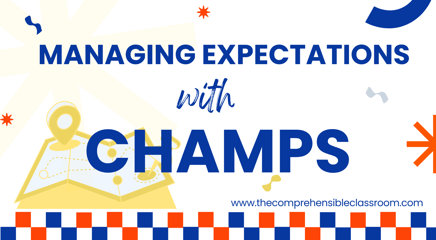We lose many minutes of precious class time to inefficient, drawn-out transitions. This is especially true when we want our students to transition out of an activity that has gotten them talking with classmates!
Use signals to help students transition from one activity to the next
Here are three strategies that I used to get my students' attention and signal a transition:
- Call and Response chants
- Ringing a bedazzled teacher bell
- Singing "Los pollitos dicen" and waiting for my students to join in
At the completion of one of these signals, my students were looking at me with closed mouths and pleading eyes, waiting with great anticipation to hear the next word that will leave my lips.... well, at least that was the expectation ;-)

My go-to Call and Response chant
When it comes to Call and Response chants, there are as many as the stars in the sky! Try as I might, I always fell back on the same C&R chant that was modeled to me by my first teaching mentor:
Teacher: "A-B-C"
Students: "CH-CH-CH"
Teacher: "Español"
Students: "¡Olé!"
Find a Call and Response chant that works for you!
Thank you to everyone on Twitter, Facebook, and email that helped me to compile this list! I shared it at a workshop that I gave in sunny Southern CA on Saturday, and I hope that all of y'all will get lots of use out of it!

My favorite signals are those of an authentic nature: whether they present a custom to students (like the one from @grantboulanger about the three different wishes for a series of three sneezes), a common colloquial expression, an idiom, or even a line from a song or poem; forming your call and response signals from authentic language is an easy way to help your students enter into the target culture.
At the elementary level especially, it is also a good idea to attach a physical response of some sort to the students' oral response. This also helps at the middle/high school level as students might not be listening to you and/or their classmates, but perhaps the physical movement will catch their eye and cause them to join in the attention-getting.
Remember to use your new Call and Response chants!
I loved to try to keep class novel by switching up the call and response signal that we used, although being a creature of habit I seemed to always fall back on old faithful. I would introduce a new call and response signal, and then I inevitably reverted back to the old standard before the week was out.
Ann Collard, who I met last summer at iFLT and saw again on Saturday at the CA workshop, said that she reminds herself to use specific call and response signals by posting the 'signal of the week' (or month, or unit) on a wall of her room. That way, she and her students which one they are currently using. Brilliant!
Find more Call and Response signals!
Beyond the Call and Response signals that I included here, there are many on this post at Spanish Playground, in this google doc by Laura Masci (with fun graphics!), and Michael Miller is the KING of Call and Response Signals (his are not language-specific, though, so I will have to include them on a future not-Spanish-specific chart).
Please share other Call and Response Signals that you have used in the comments, especially if they are in languages other than Spanish!
And in the meantime... call and respond away!





